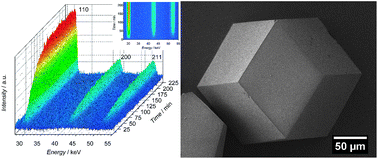Formate modulated solvothermal synthesis of ZIF-8 investigated using time-resolved in situ X-ray diffraction and scanning electron microscopy†
Abstract
Time-resolved investigations using in situ energy-dispersive

* Corresponding authors
a
Institut für Anorganische Chemie, Leibniz Universität Hannover, Callinstr. 9, Hannover, Germany
E-mail:
michael.wiebcke@acb.uni-hannover.de, janosch.cravillon@acb.uni-hannover.de
Fax: +49-511-7623006
Tel: +49-511-7623698
b Institut für Physikalische Chemie und Elektrochemie, Leibniz Universität Hannover, Callinstr. 3A, Hannover, Germany
c Deutsches Elektronen-Synchrotron (DESY), Notkestr. 85, Hamburg, Germany
Time-resolved investigations using in situ energy-dispersive

 Please wait while we load your content...
Something went wrong. Try again?
Please wait while we load your content...
Something went wrong. Try again?
J. Cravillon, C. A. Schröder, H. Bux, A. Rothkirch, J. Caro and M. Wiebcke, CrystEngComm, 2012, 14, 492 DOI: 10.1039/C1CE06002C
To request permission to reproduce material from this article, please go to the Copyright Clearance Center request page.
If you are an author contributing to an RSC publication, you do not need to request permission provided correct acknowledgement is given.
If you are the author of this article, you do not need to request permission to reproduce figures and diagrams provided correct acknowledgement is given. If you want to reproduce the whole article in a third-party publication (excluding your thesis/dissertation for which permission is not required) please go to the Copyright Clearance Center request page.
Read more about how to correctly acknowledge RSC content.
 Fetching data from CrossRef.
Fetching data from CrossRef.
This may take some time to load.
Loading related content
